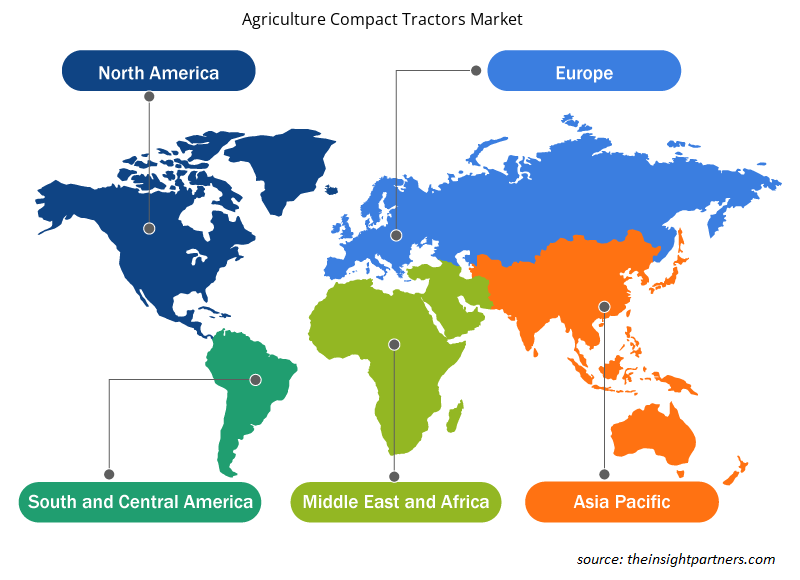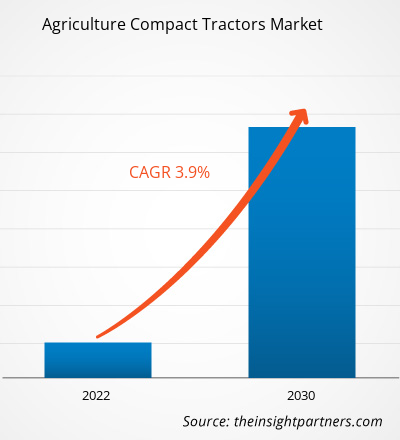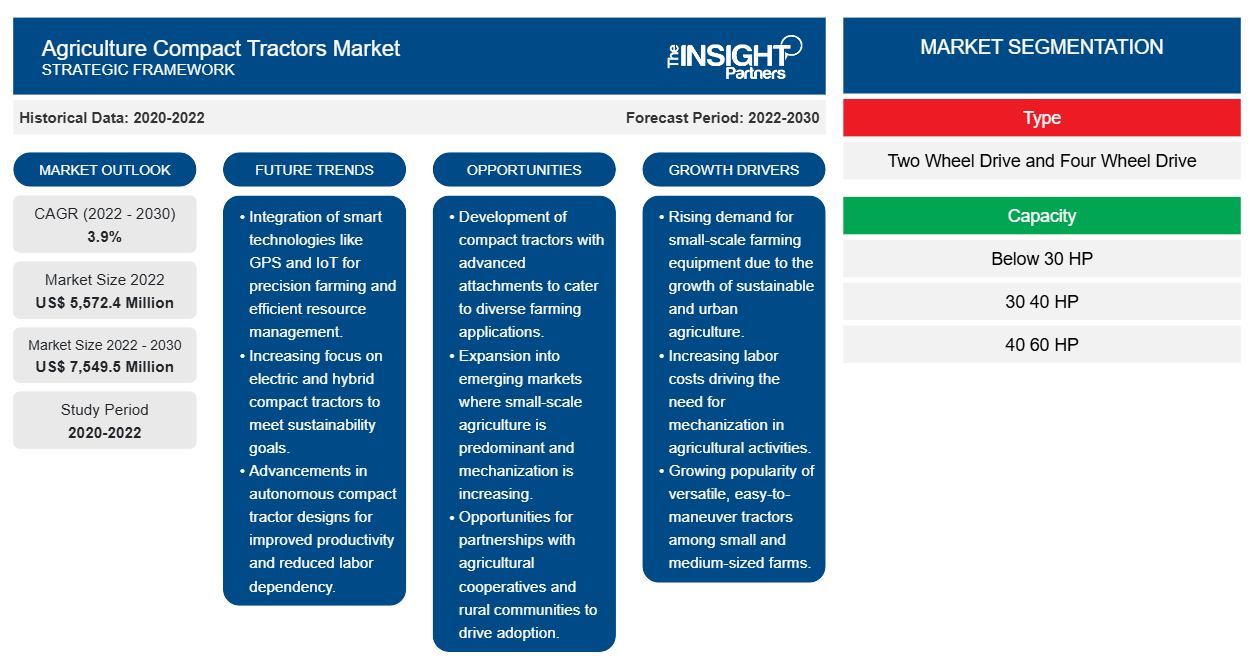[Rapport de recherche] La taille du marché des tracteurs compacts agricoles devrait passer de 5 572,4 millions USD en 2022 à 7 549,5 millions USD d'ici 2030 ; le marché devrait enregistrer un TCAC de 3,9 % de 2022 à 2030.
Point de vue de l'analyste :
Le secteur agricole en croissance continue, ainsi qu'une préférence croissante pour les équipements modernes, stimulent la croissance du marché mondial des tracteurs agricoles compacts . La demande de nourriture augmente avec une population en constante augmentation. Selon les récentes prévisions des Nations Unies, la population mondiale devrait atteindre 8,5 milliards d'ici 2030 et 9,7 milliards d'ici 2050. En conséquence, la demande de produits agricoles augmente rapidement, ce qui oblige les agriculteurs à améliorer les rendements de leurs exploitations. Par conséquent, l'échelle croissante des activités agricoles propulse la demande de tracteurs agricoles compacts.
En janvier 2024, LS Mtron Co., un fabricant sud-coréen de machines lourdes et de composants électroniques, a lancé la nouvelle série de petits tracteurs MT2·MT2E en Amérique du Nord. Les deux modèles de cette série, le MT2 haut de gamme et le MT2E économique, sont conçus pour améliorer le confort d'utilisation dans les endroits restreints et conviennent à l'agriculture à petite échelle. Cette gamme de produits a été conçue pour divers travaux, notamment une navette facile à utiliser pour des opérations avant et arrière en douceur, et des pédales doubles adaptées au transfert de terre ou de gravier. De telles activités de développement de produits par les fabricants de tracteurs agricoles compacts alimentent la croissance du marché des tracteurs agricoles compacts.
Aperçu du marché :
Les tracteurs compacts, généralement appelés tracteurs utilitaires compacts, sont principalement utilisés pour les petites activités agricoles telles que le labourage, la tonte, la plantation, le labourage et le transport. Ils sont plus petits en taille et en capacité, et plus avantageux pour les petites exploitations, les vergers et les vergers de noix, les vignobles, les jardins et les pelouses. Les tracteurs compacts consomment moins de carburant et nécessitent peu d'entretien, ce qui se traduit par de faibles coûts d'exploitation.
L'Asie-Pacifique domine le marché des tracteurs agricoles compacts en raison de l'ampleur des activités agricoles dans des pays comme la Chine et l'Inde. Cependant, l'Amérique du Nord et l'Europe devraient enregistrer de fortes valeurs de TCAC au cours de la période de prévision. Les États-Unis sont l'un des principaux producteurs de noix et de fruits. Selon les données publiées par le ministère américain de l'Agriculture en 2022, les petites exploitations familiales représentaient 88 % du total des exploitations agricoles aux États-Unis. Ainsi, la présence d'un grand nombre de petites exploitations aux États-Unis est un facteur clé qui profite au marché des tracteurs agricoles compacts dans ce pays.
Personnalisez ce rapport en fonction de vos besoins
Vous bénéficierez d'une personnalisation gratuite de n'importe quel rapport, y compris de certaines parties de ce rapport, d'une analyse au niveau des pays, d'un pack de données Excel, ainsi que de superbes offres et réductions pour les start-ups et les universités.
-
Obtenez les principales tendances clés du marché de ce rapport.Cet échantillon GRATUIT comprendra une analyse de données, allant des tendances du marché aux estimations et prévisions.
Moteur du marché :
Initiatives gouvernementales pour soutenir les petits exploitants agricoles
Les politiques gouvernementales et les initiatives de soutien telles que le financement augmentent le nombre de petites exploitations agricoles dans différents pays. Par exemple, le ministère américain de l'Agriculture propose un programme de microcrédit aux petits agriculteurs et aux agriculteurs débutants qui leur permet d'obtenir jusqu'à 35 000 USD de prêts grâce à de simples demandes. De plus, en 2023, le gouvernement du Guyana a annoncé une initiative dans le cadre de son programme National Pathway for Food Systems. Dans le cadre de ce projet, des fournitures d'intrants agricoles et une subvention ponctuelle en espèces ont été fournies aux petits exploitants agricoles et aux participants à des programmes continus d'autonomisation socio-économique dans tout le pays. De telles initiatives gouvernementales permettent aux petits agriculteurs d'adopter des équipements agricoles, notamment des tracteurs compacts. De plus, ces programmes et initiatives créent un environnement propice aux petites exploitations agricoles dans les pays en développement et développés, ce qui se traduit en fin de compte par l'expansion de la taille du marché des tracteurs compacts agricoles.
Analyse segmentaire :
L'analyse du marché des tracteurs agricoles compacts a été réalisée en prenant en compte les segments suivants : type, capacité et application. Sur la base de la capacité, le marché est segmenté en moins de 30 CV, 30 CV-40 CV et 40 CV-60 CV. Les segments 40 CV-60 CV et 30 CV-40 CV représentent collectivement plus de 50 % de la part de marché des tracteurs agricoles compacts. Ces tracteurs conviennent aux exploitations de taille moyenne pour des tâches telles que le labour, le labourage, la plantation et la récolte. Par exemple, Farmtrac a lancé son nouveau tracteur Farmtrac 60 Powermaxx en 2024. Ce tracteur est doté d'un moteur de 55 CV et offre plusieurs fonctionnalités.
Analyse régionale :
La portée géographique du rapport sur le marché des tracteurs compacts agricoles comprend l’Amérique du Nord (États-Unis, Canada et Mexique), l’Europe (Espagne, Royaume-Uni, Allemagne, France, Italie et reste de l’Europe), l’Asie-Pacifique (Corée du Sud, Chine, Inde, Japon, Australie et reste de l’Asie-Pacifique), le Moyen-Orient et l’Afrique (Afrique du Sud, Arabie saoudite, Émirats arabes unis et reste du Moyen-Orient et de l’Afrique) et l’Amérique du Sud et centrale (Brésil, Argentine et reste de l’Amérique du Sud et centrale). L’Asie-Pacifique représentait la plus grande part de marché des tracteurs compacts agricoles en 2022.
Le marché nord-américain des tracteurs agricoles compacts est segmenté entre les États-Unis, le Canada et le Mexique. Le secteur agricole en Amérique du Nord, en particulier dans des pays comme les États-Unis, le Canada et le Mexique, stimule principalement la demande de tracteurs agricoles compacts. L'expansion du secteur agricole et les développements continus de produits continueront de stimuler le marché dans cette région à l'avenir. Selon les données publiées par le ministère américain de l'Agriculture en 2021, le secteur agricole a contribué à hauteur d'environ 1 264 milliards de dollars américains au PIB américain en 2021, soit 5,4 % du PIB national. Selon les données publiées par le gouvernement canadien en 2022, le secteur agricole et agroalimentaire apporte une contribution significative à l'économie canadienne. Les ventes canadiennes de produits agricoles, en croissance à un taux annuel de 5,6 %, ont totalisé 87,7 milliards de dollars américains en 2022. Le nombre croissant de petites exploitations agricoles entraîne une demande accrue de tracteurs compacts, ce qui offre de nouvelles perspectives de croissance aux fournisseurs. En outre, de nombreux acteurs clés aux États-Unis se concentrent désormais sur le développement de tracteurs compacts entièrement automatisés, et ces développements devraient apporter de nouvelles tendances au marché des tracteurs compacts agricoles en Amérique du Nord dans les années à venir.
Aperçu régional du marché des tracteurs compacts agricoles
Les tendances et facteurs régionaux influençant le marché des tracteurs compacts agricoles tout au long de la période de prévision ont été expliqués en détail par les analystes d’Insight Partners. Cette section traite également des segments et de la géographie du marché des tracteurs compacts agricoles en Amérique du Nord, en Europe, en Asie-Pacifique, au Moyen-Orient et en Afrique, ainsi qu’en Amérique du Sud et en Amérique centrale.

- Obtenez les données régionales spécifiques au marché des tracteurs compacts agricoles
Portée du rapport sur le marché des tracteurs compacts agricoles
| Attribut de rapport | Détails |
|---|---|
| Taille du marché en 2022 | 5 572,4 millions de dollars américains |
| Taille du marché d'ici 2030 | 7 549,5 millions de dollars américains |
| Taux de croissance annuel moyen mondial (2022-2030) | 3,9% |
| Données historiques | 2020-2022 |
| Période de prévision | 2022-2030 |
| Segments couverts |
Par type
|
| Régions et pays couverts |
Amérique du Nord
|
| Leaders du marché et profils d'entreprises clés |
|
Densité des acteurs du marché des tracteurs compacts agricoles : comprendre son impact sur la dynamique commerciale
Le marché des tracteurs compacts agricoles connaît une croissance rapide, tirée par la demande croissante des utilisateurs finaux en raison de facteurs tels que l'évolution des préférences des consommateurs, les avancées technologiques et une plus grande sensibilisation aux avantages du produit. À mesure que la demande augmente, les entreprises élargissent leurs offres, innovent pour répondre aux besoins des consommateurs et capitalisent sur les tendances émergentes, ce qui alimente davantage la croissance du marché.
La densité des acteurs du marché fait référence à la répartition des entreprises ou des sociétés opérant sur un marché ou un secteur particulier. Elle indique le nombre de concurrents (acteurs du marché) présents sur un marché donné par rapport à sa taille ou à sa valeur marchande totale.
Les principales entreprises opérant sur le marché des tracteurs compacts agricoles sont :
- Tracteur YANMAR
- Mahindra
- SOCIÉTÉ TYM
- Solelectrac
- John Deere
Avis de non-responsabilité : les sociétés répertoriées ci-dessus ne sont pas classées dans un ordre particulier.

- Obtenez un aperçu des principaux acteurs du marché des tracteurs compacts agricoles
Analyse des acteurs clés :
AGCO GmbH, Yamaha Tractors, Solis, Bobcat Company, Mahindra Tractors, Kubota, John Deere, Massey Ferguson et New Holland font partie des principaux acteurs présentés dans le rapport sur le marché des tracteurs compacts agricoles. Outre ces acteurs, plusieurs autres entreprises importantes ont été étudiées et analysées au cours de cette étude pour obtenir un aperçu global du marché mondial des tracteurs compacts utilitaires.
Développements récents :
Les stratégies inorganiques et organiques telles que les fusions et acquisitions sont largement adoptées par les entreprises du marché mondial des tracteurs agricoles compacts. Quelques développements récents des principaux acteurs du marché des tracteurs agricoles compacts, selon les communiqués de presse, sont énumérés ci-dessous :
Année |
Nouvelles |
Région |
|
Août 2023 |
Case IH a lancé ses nouveaux tracteurs Farmall Subcompact 25SC. Ce nouveau modèle est le plus petit tracteur de la gamme Case IH. Le nouveau tracteur est doté d'une gamme de moteurs allant de 25 à 115 ch. |
Asie-Pacifique |
|
Février 2023 |
Bobcat a présenté une nouvelle gamme de tracteurs compacts, baptisée séries 1000, 2000 et 4000. La série comprend neuf modèles de tracteurs compacts qui se différencient en fonction de la puissance du moteur. Ces tracteurs ont une plage de puissance comprise entre 25 et 85 CV. |
Europe |
- Analyse historique (2 ans), année de base, prévision (7 ans) avec TCAC
- Analyse PEST et SWOT
- Taille du marché Valeur / Volume - Mondial, Régional, Pays
- Industrie et paysage concurrentiel
- Ensemble de données Excel
Rapports récents
Témoignages
Raison d'acheter
- Prise de décision éclairée
- Compréhension de la dynamique du marché
- Analyse concurrentielle
- Connaissances clients
- Prévisions de marché
- Atténuation des risques
- Planification stratégique
- Justification des investissements
- Identification des marchés émergents
- Amélioration des stratégies marketing
- Amélioration de l'efficacité opérationnelle
- Alignement sur les tendances réglementaires























 Obtenez un échantillon gratuit pour - Marché des tracteurs compacts agricoles
Obtenez un échantillon gratuit pour - Marché des tracteurs compacts agricoles